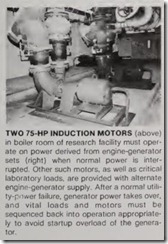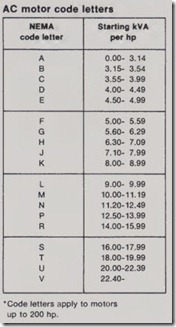Starting and running induction motors on engine-generator power
MOTORS THA T OPERATE on power supplied from an engine-generator source must be properly selected and applied to assure long life anG depend able operation. Of course, the power source must also be chosen with care, since proper voltage and starting capa bility is vital to the efficiency and reli ability of motor operation.
Upon startup, AC induction motors draw several times their rated full-load current. Because of this, a generator set output voltage will dip until the motor reaches its operating speed. The amount of dip depends on generator preload and generator capacity. ‘!’1-!e permissible voltage drop depends on the application. Voltage dips up to 30% may be tolerated when starting an unloaded motor; dips greater than 30% should not be permitted because mag netic contactors in the control circuits of other meters on the line may open if the voltage drops below 70% of rated value. Where lighting loads or sensitive equipment share the generator capaci ty with motors, large or repeated volt age dips usually are objectionable.
Properly matched generator sets operating in parallel will share motor starting kVA fairly well. Even units of different sizes but of the same manu facturer and configuration furnished with similar items such as generator type, governor, regulator, etc. will pro portionally divide the load according to their respective ratings. It is common practice, or “rule-of-thumb,” to in crease starting kVA by 10% to account for differences in adjustments, produc tion tolerances, and circulating currents.
The ability to predict the starting kV A division between dissimilar gen erator sets from different manufactur ers is based primarily on experience, and it is advisable to consult with the suppliers of the various equipment involved.
When starting large motors, there are momentary, large kVA demands placed on the generator. Since this is apparent power and not real oower. the engine is not affected to a large extent. It becomes critical in starting motors that the generator has the capability to provide this momentary kV A without excessive voltage dip.
The starting kVA of a motor is easi ly calculated by either of two methods. A NEMA motor code lists the starting kV A per hp using the letters shown in the accompanying chart. The second method is to use the locked-rotor cur rent rating for the motor and calculate the kVA demand. The locked-rotor cur rent valut.; IS standard and is given on the motor nameplate. The calculatio;1 procedure is as follows: 
The most-commonly used motor is the squirrel-cage induction motor, and the most-commonly used type is a NEMA design B, which frequently is classified as a Code F motor. If spe ‘ific data is not available for any reason, an SkVA of 5.3 kVA/hp can be used for estimating purposes.
When starting several large motors in sequence, it is important to consider the effect that motors already running will have on the generator. The kVA capacity of the generator is limited; therefore, the reserve kVA available becomes more limited as each motor is started. Oversizing the generator rela tive to engine hp to gain additional motor-starting capability can be ad vantageous.
In those installations where short voltage recovery time is necessary dur ing motor starting, improved recovery characteristics are obtained when the generator set is at about 75% load, assuming sufficient motor starting kVA is available. At 75% load, the voltage regulator is maintaining a high excitation level.
Where multiple motors are to be started, it is advisable to start the largest motors first. Sequencing can be done manually as a part of the startup procedure or with an automatic se quencing device. For e”ngine generator sets, it is important that not all motors on the line attempt to restart at once when the generator set picks up the load. Only motors critical to emergen cy-power operations should be allowed to restart automatically. If the total starting kVA of these motors plus oth er emergency load requirements exceed the motor starting kVA rating of the generator set, provision must be made to sequence the starting of these essen tial motors automatically.
If problems occur during starting of motors, one or more of the following suggestions may be bel pful:
1. Specify an oversized generator and improve the system power factor. This reduces the generator set require ment to produce reactive kVA, making more kVA available for starting.
2. Use reduced-voltage starters. This reduces the kVA required to start a given motor. If starting under load, remember that this method of starting also reduces starting torque.
3. Use wound-rotor motors. They require much lower starting current, although they are more expensive than induction motors.
4. Provide clutches so motors may be started before loads are applied to them. While the starting kVA demand of the motor is not reduced, the time interval of high kV A demand is reduced.
5. Change starting sequence; start largest motors first. More kVA is available for starting, although it does not provide better voltage recovery time.
6. Use a motor-generator set. A motor drives the generator which, in turn, supplies power to the motor to be started, as is done, for example, in elevator service. The motor-generator set runs continuously, and the current surge caused by the starting of the equipment motor is absorbed by the motor-generator-set inertia.

